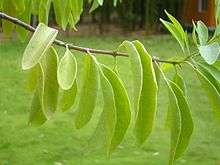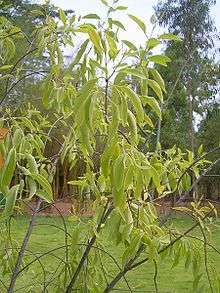Santalum album
Santalum album, or Indian sandalwood, is a small tropical tree, and is the most commonly known source of sandalwood. It is native to southern India and Southeast Asia. Certain cultures place great significance on its fragrant and medicinal qualities. It is also considered sacred in some religions and is used in different religious traditions. The high value of the species has caused its past exploitation, to the point where the wild population is vulnerable to extinction. Indian sandalwood still commands high prices for its essential oil, but due to lack of sizable trees it is no longer used for fine woodworking as before. The plant is widely cultivated and long lived, although harvest is only viable after many years. Etymologically it is derived from Sanskrit चन्दनं chandanam.[2]
| Santalum album | |
|---|---|
 | |
| Scientific classification | |
| Kingdom: | Plantae |
| Clade: | Tracheophytes |
| Clade: | Angiosperms |
| Clade: | Eudicots |
| Order: | Santalales |
| Family: | Santalaceae |
| Genus: | Santalum |
| Species: | S. album |
| Binomial name | |
| Santalum album | |
Description
_in_Hyderabad%2C_AP_W2_IMG_0023.jpg)
The height of the evergreen tree is between 4 and 9 metres. They may live to one hundred years of age. The tree is variable in habit, usually upright to sprawling, and may intertwine with other species. The plant parasitises the roots of other tree species, with a haustorium adaptation on its own roots, but without major detriment to its hosts. An individual will form a non-obligate relationship with a number of other plants. Up to 300 species (including its own) can host the tree's development - supplying macronutrients phosphorus, nitrogen and potassium, and shade - especially during early phases of development. It may propagate itself through wood suckering during its early development, establishing small stands. The reddish or brown bark can be almost black and is smooth in young trees, becoming cracked with a red reveal. The heartwood is pale green to white as the common name indicates. The leaves are thin, opposite and ovate to lanceolate in shape. Glabrous surface is shiny and bright green, with a glaucous pale reverse. Fruit is produced after three years, viable seeds after five. These seeds are distributed by birds.
Nomenclature
The nomenclature for other "sandalwoods" and the taxonomy of the genus are derived from this species' historical and widespread use. Santalum album is included in the family Santalaceae, and is commonly known as white or East Indian sandalwood.[3] The name, Santalum ovatum, used by Robert Brown in Prodromus Florae Novae Hollandiae (1810) was described as a synonym of this species by Alex George in 1984.[4] The epithet album refers to the 'white' of the heartwood.
The species was the first to be known as sandalwood. Other species in the genus Santalum, such as the Australian S. spicatum, are also referred to as true sandalwoods, to distinguish them from trees with similar-smelling wood or oil.
Distribution
Santalum album L. is indigenous to the tropical belt of the peninsular India, eastern Indonesia and northern Australia.[5][6] The main distribution is in the drier tropical regions of India and the Indonesian islands of Timor and Sumba.[7] There is still debate as to whether S. album is endemic to Australia and India or was introduced by fishermen, traders or birds from southeast Asia centuries ago.[8][9]
Sandalwood is now cultivated in India, Sri Lanka, Indonesia, Malaysia, the Philippines and Northern Australia.
Habitat and Growth
S. album occurs from coastal dry forests up to 700 m elevation. It normally grows in sandy or well drained stony red soils, but a wide range of soil types are inhabited. This habitat has a temperature range from 0 to 38 °C and annual rainfall between 500 and 3000 mm. S. album can grow up to 30 feet vertically. It should be planted in good sunlight and does not require a lot of water. The tree starts to flower after 7 years. When the tree is still young the flowers are white and with age they turn red or orange. The trunk of the tree starts to develop its fragrance after about 10 years of growth.

Conservation
S. album is recognized as a "vulnerable" species by the International Union for the Conservation of Nature (IUCN).[10] It is threatened by over-exploitation and degradation to habitat through altered land use, fire (to which this species is extremely sensitive), Spike disease, agriculture, and land-clearing are the factors of most concern. To preserve this vulnerable resource from over-exploitation, legislation protects the species, and cultivation is researched and developed.[11][12][13]
Until 2002, individuals in India were not allowed to grow sandalwood. Due to its scarcity, sandalwood is not allowed to be cut or harvested by individuals. The State grants specific permission to officials who then can cut down the tree and sell its wood.[14] The Indian government has placed a ban on the export of the timber.[1]
Uses

S. album has been the primary source of sandalwood and the derived oil. These often hold an important place within the societies of its naturalised distribution range. The central part of the tree, the heartwood, is the only part of the tree that is used for its fragrance. It is yellow-brown in color, hard with an oily texture and due to its durability, is the perfect material for carving. The outer part of the tree, the sapwood, is unscented. The sapwood is white or yellow in color and is used to make turnery items. The high value of sandalwood has led to attempts at cultivation, this has increased the distribution range of the plant. The ISO Standard for the accepted characteristics of this essential oil is ISO 3518:2002.[15] HPTLC and GC,[16] GC-MS based methods are used for qualitative and quantitative analyses of the volatile [17] essential oil constituents. The long maturation period and difficulty in cultivation have been restrictive to extensive planting within the range. Harvest of the tree involves several curing and processing stages, also adding to the commercial value. These wood and oil have high demand and are an important trade item in the regions of:
- India
- The use of S. album in India is noted in literature for over two thousand years. It has use as wood and oil in religious practices. It also features as a construction material in temples and elsewhere. The Indian government has banned the export of the species to reduce the threat by over-harvesting. In the southern Indian states of Karnataka and Andhra Pradesh all trees of greater than a specified girth are the property of the state. Cutting of trees, even on private property, is regulated by the Forest Department.[18] The infamous forest bandit Veerappan was involved in the illegal felling of sandalwood trees from forests.
- Sri Lanka
- The harvesting of sandalwood is preferred to be of trees that are advanced in age. Saleable wood can, however, be of trees as young as seven years. The entire plant is removed rather than cut to the base, as in coppiced species. The extensive removal of S. album over the past century led to increased vulnerability to extinction.[1]
- Australia
- Utilisation of native Australian Santalum species in has been extensive; Santalum spicatum was extensively harvested and exported from Western Australia during colonisation, this was used as a less expensive alternative to this species. There are two commercial Indian sandalwood plantations in full operation based in Kununurra, Western Australia.[19][20]
Ethnopharmacological Uses
Sandalwood oil has been widely used in folk medicine for treatment of common colds, bronchitis, skin disorders, heart ailments, general weakness, fever, infection of the urinary tract, inflammation of the mouth and pharynx, liver and gallbladder complaints and other maladies.[21] Recently, the in vivo anti-hyperglycemic and antioxidant potentials[22] of α-santalol and sandalwood oil were demonstrated in Swiss Albino mice. Additionally, different in vitro and in vivo parts of the plant have been shown to possess antimicrobial[23] and antioxidant[23] properties, possibly attributed to sesquiterpenoids,[24] shikimic acid,[25] etc.
See also
- Sandal spike phytoplasma - disease of S. album
References
- Asian Regional Workshop (1998). "Santalum album". IUCN Red List of Threatened Species. 1998. Retrieved 2007-02-08.CS1 maint: ref=harv (link)
- http://www.etymonline.com/index.php?term=sandalwood
- Santalum (IPNI)
- "Santalum ovatum". Australian Plant Name Index (APNI), IBIS database. Centre for Plant Biodiversity Research, Australian Government. George, A.S. & Hewson, H.J. in George, A.S. (Ed) (1984), Flora of Australia 22: 61, 63, Fig. 18D, Map 71
- Orwa, Mutua. "Santalum album L. (Orwa et al.2009)" (PDF). old.worldagroforestry.org. Agroforestry Database. Retrieved 4 April 2009.
- Dhanya, Bhaskar. "Sandal (Santalum album L.) conservation in southern India: A review of policies and their impacts". researchgate.net. Researchgate. Retrieved 12 June 2010.
- Orwa, Mutua. "Santalum album L. (Orwa et al.2009)" (PDF). old.worldagroforestry.org. Agroforestry Database. Retrieved 4 April 2009.
- Zumbroich, Thomas J. (2007–2008). "The origin and diffusion of betel chewing: a synthesis of evidence from South Asia, Southeast Asia and beyond". eJournal of Indian Medicine. 1: 87–140.CS1 maint: date format (link)
- Orwa, Mutua. "Santalum album L. (Orwa et al.2009)" (PDF). old.worldagroforestry.org. Agroforestry Database. Retrieved 4 April 2009.
- teamKraftt. "CONSERVATION & ENVIRONMENTAL |". sandalwoodoilspecialist.com. Retrieved 2017-04-05.
- http://www.newcrops.uq.edu.au/newslett/ncnl2-54.htm University of Queensland site's detail
- Australian Arid Lands Botanic Garden - Plants: Sandalwood, Santalum spicatum
- "Archived copy" (PDF). Archived from the original (PDF) on 2006-09-20. Retrieved 2007-01-31.CS1 maint: archived copy as title (link) WA Gov site's detail
- Vijay, Hema. "Time to lift restrictions on planting sandalwood?". The Hindu. Retrieved 2017-04-05.
- ISO 3518:2002
- Misra, B. B.; Dey, S. "Quantitative and qualitative evaluation of esquiterpenoids from essential oil and in vitro somatic embryos of east Indian Sandalwood (Santalum album) tree by HPTLC and GC". Journal of Medicinal and Aromatic Plants. 4 (1): 1–9.
- Misra, Biswapriya B.; Das, Shibendu S.; Dey, Satyahari (2013). "Volatile profiling from heartwood of East Indian sandalwood tree". Journal of Pharmacy Research. 7 (4): 299–303. doi:10.1016/j.jopr.2013.04.030.
- Karnataka Forest Department Rules Archived 2007-02-17 at the Wayback Machine
- Indian Sandalwood Plantations in Australia. Tropical Forest Services (TFS) Ltd.
- Indian Sandalwood in Western Australia. Santanol
- Misra, BB; Dey, S (2013). "Biological Activities of East Indian Sandalwood Tree, Santalum album". PeerJ PrePrints. 1: e96. doi:10.7287/peerj.preprints.96v1.
- Misra, Biswapriya B.; Dey, Satyahari (2013). "Evaluation of in vivo anti-hyperglycemic and antioxidant potentials of α-santalol and sandalwood oil". Phytomedicine. 20 (5): 409–16. doi:10.1016/j.phymed.2012.12.017. PMID 23369343.
- Misra, B.B.; Dey, S. (2012). "Comparative phytochemical analysis and antibacterial efficacy of in vitro and in vivo extracts from East Indian sandalwood tree (Santalum album L.)". Letters in Applied Microbiology. 55 (6): 476–486. doi:10.1111/lam.12005. PMID 23020220.
- Misra, Biswapriya B.; Dey, Satyahari (2012). "Differential Extraction and GC-MS based Quantification of Sesquiterpenoids from Immature Heartwood of East Indian Sandalwood Tree". Journal of Natural Sciences Research. 2 (6): 29–33.
- Misra, Biswapriya B.; Dey, Satyahari (2013). "Shikimic Acid (Tamiflu Precursor) Production in Suspension Cultures of East Indian Sandalwood (Santalum album) in Air-lift Bioreactor". Journal of Postdoctoral Research. 1 (1): 1–9.
External links
- Tennakoon, Kushan U.; Cameron, Duncan D. (2006). "The anatomy of Santalum album (Sandalwood) haustoria". Canadian Journal of Botany. 84 (10): 1608–16. doi:10.1139/b06-118.


- Homepage of Professor Satyahari Dey, at Department of Biotechnology, IIT Kharagpur, India: Working on Indian Sandalwood since 20 years
- Caldecott, Todd (2006). Ayurveda: The Divine Science of Life. Elsevier/Mosby. ISBN 0-7234-3410-7. Contains a detailed monograph on Santalum album (Chandana) as well as a discussion of health benefits and usage in clinical practice. Available online at https://web.archive.org/web/20110616193403/http://www.toddcaldecott.com/index.php/herbs/learning-herbs/379-chandana

